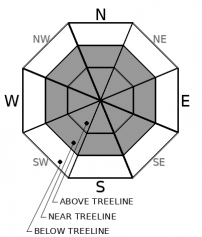| Tuesday | Tuesday Night | Wednesday | |
|---|---|---|---|
| Weather: | Partly cloudy. Snow levels below 7000 feet. Chance of precipitation is 5%. | Partly cloudy then becoming mostly cloudy. Snow levels below 7000 feet. Chance of precipitation is 10%. | Mostly cloudy then becoming partly cloudy. Slight chance of snow in the morning. Snow levels below 7000 feet. Chance of precipitation is 10%. |
| Temperatures: | 38 to 43. deg. F. | 20 to 26. deg. F. | 34 to 39. deg. F. |
| Mid Slope Winds: | Light winds. | Light winds becoming southwest 10 to 15 mph with gusts to 40 mph after midnight. | West 10 to 15 mph with gusts to 35 mph in the morning becoming light. |
| Expected snowfall: | No accumulation. | SWE = none. | No accumulation. | SWE = none. | 90% probability no accumulation. 10% probability up to 1 inch. | SWE = none. |
| Tuesday | Tuesday Night | Wednesday | |
|---|---|---|---|
| Weather: | Partly cloudy then becoming sunny. Snow levels below 7000 feet. Chance of precipitation is 5%. | Partly cloudy then becoming mostly cloudy. Snow levels below 7000 feet. Chance of precipitation is 10%. | Mostly cloudy then becoming partly cloudy. Snow levels below 7000 feet. Chance of precipitation is 10%. |
| Temperatures: | 35 to 41. deg. F. | 19 to 24. deg. F. | 31 to 36. deg. F. |
| Ridge Top Winds: | Northeast 10 to 15 mph with gusts to 30 mph. | West 15 to 25 mph. Gusts up to 30 mph increasing to 55 mph after midnight. | North 15 to 30 mph with gusts to 65 mph. |
| Expected snowfall: | No accumulation. | SWE = none. | No accumulation. | SWE = none. | 90% probability no accumulation. 10% probability up to 1 inch. | SWE = none. |

























